PhD Theses
Please click on the title of the thesis to see the full text options.

Advancing sustainability in vat photopolymerization through photopolymer resin design
(2025) Tao Zhang
This thesis explores the integration of dynamic covalent chemistry into photoresins as an alternative to traditional permanent covalent bonds. Conventional 3D printed materials are inherently static, lacking adaptability once fabricated. By leveraging the reversible nature of dynamic covalent bonds, printed polymers gain adaptability and responsiveness even after the printing process.
The central aim of this work is to investigate dynamic behavior in printed polymers, particularly shape memory effects, while advancing green synthesis and sustainable design principles in photoresin development. Traditional 3D printing processes are often constrained by the irreversibility of the final printed shape. Reconfiguration requires reprinting and discarding the previous structure, contributing to material waste. In contrast, embedding dynamic covalent bonds into the polymeric network enables reshaping and reprocessing post-fabrication thus granting a second life to printed materials.
Chapter 1 introduces the principles of dynamic covalent chemistry and its relevance to adaptive, sustainable and recyclable photopolymer systems. Chapter 2 demonstrates a dynamic photoresin system capable of color change and shape reconfiguration via environmental stimuli. Chapter 3 extends adaptive concept by incorporating aroma responsiveness using a renewable essential oil. Chapter 4 focuses on the green synthesis of photoresins using renewable feedstocks and solvent-free processing. Chapter 5 outlines a scalable, one-step method to prepare biodegradable photoresins suitable for vat photopolymerization.

Design of Starch-Based Self-Healing Hydrogels Based on Dynamic Borate Ester Bonds
(2025) Kai Lu
Starches have attracted increasing research interest since they are renewable, biodegradable, and cost effective. Due to undesirable qualities such as poor solubility, a high degree of retrogradation, and poor thermal stability, native starches have been modified using various methods to enhance their functional properties and broaden their industrial applications. Meanwhile, starch molecules contain abundant hydroxyl groups and can be easily chemically or physically crosslinked to form hydrogels, and starch hydrogels have been widely used in many fields owing to their biocompatibility and renewability.
However, starch hydrogels generally have weak mechanical properties due to their single-network structure with low cross-link density, which requires enhancement through grafting with functional monomers. Moreover, their tendency to incur damage after repeated use limits their effectiveness in practical applications.
This thesis revolves around the design of a series of starch-based self-healing hydrogels by using borax as a cross-linker and the combination of other biocompatible raw materials, including CNCs, chitosan, and PVA. This study explores the impact of synergistic dual reversible crosslinking of borate ester bonds and hydrogen bonds on the mechanical properties, thermal responsiveness, and self-healing capabilities of hydrogels. The starch-based hydrogels developed here have the potential to open the door to new functional materials for various applications, including agriculture, sensor technology, and wastewater treatment. Overall, this thesis contributes to a deeper understanding of starch-based self-healing hydrogels, enabling the advancement of novel and improved applications for these materials.
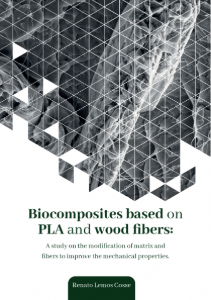
Biocomposites based on PLA and wood fibers: a study on the modification of matrix and fibers to improve the mechanical properties
(2025) Renato Lemos Cosse
Reducing the carbon footprint in the current global context is imperative. Replacing products with high environmental impact has become essential. Therefore, there is an increasing effort to substitute plastics, especially with materials derived from renewable sources that do not take hundreds of years to degrade.
In this regard, natural fibers, such as wood fibers, have proven to be valuable allies in enhancing the mechanical properties of bioplastics. This allows for reduced plastic usage in product manufacturing while simultaneously moving away from fossil-based plastics.
Our study demonstrated that a combination of thermal treatment and chemical functionalization significantly improves the mechanical properties of bioplastics, making them even more suitable for everyday applications.
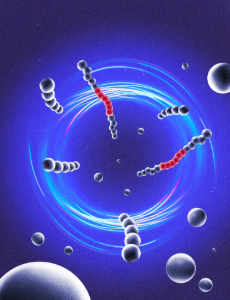
Metal-Free Light-Catalyzed Atom Transfer Radical Polymerization for the Synthesis of Poly(vinylidene fluoride)-based Block Copolymers
(2024) Aldo Altomare
This thesis explores the applicability of metal-free light-catalyzed atom transfer radical polymerization to the synthesis of PVDF-based block copolymers. In chapter two, a series of organic photoredox catalysts coupled with light of different wavelengths is explored. These photoredox catalysts work through either and oxidative quenching pathway or a reductive quenching pathway. They are tested under the same conditions to pick the more suitbale to the synthesis of the wanted PVDF-based block copolymers.
In chapter three, a series of reaction parameters, namely the end-group on the PVDF macroinitiator, the concentration of the organic photoredox catalyst and the concentration of the monomer chosen for the second block are studied.
In chapter four, the information gained in chapters two and three are applied for the synthesis of PS-b-PVDF-b-PS block copolymer. The synthesized block copolymers are then characterized at the solid state and after processing in thin films. In particular, the thermal properties are studied as well as the crystalline phase composition. The block copolymers are then characterized in solution to studied the morphology of the objects formed in mixtures of different solvents.
In chapter five, the same principles are applied for the synthesis of P4VP-b-PVDF-b-P4VP block copolymer. The synthesized block copolymers are then characterized at the solid state and after processing in thin films. In particular, the thermal properties are studied as well as the crystalline phase composition. The block copolymers are then characterized in solution to studied the morphology of the objects formed in mixtures of different solvents.
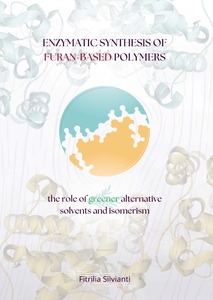
Enzymatic synthesis of furan-based polymers: the role of greener alternative solvents and isomerism
(2024) Fitrilia SilviantiEnzymatic polymer synthesis is a widely recognized polymerization method that has proven effective for achieving greener synthesis routes with high catalytic selectivity. The growing demand for environmentally friendly and sustainable processes has been amplified by increasing environmental awareness, thereby driving the development of green synthesis techniques in polymer science.
The coupling of biobased raw materials with enzyme catalysis has made the synthesis of polymeric materials more environmentally friendly compared to conventional polymerization methods. Among biobased building blocks, 2,5-furandicarboxylic acid (FDCA) is extensively studied and used for polymer synthesis. With the increasing popularity of 2,5-FDCA, its isomeric counterparts, 2,4- and 3,4-FDCA, have recently gained attention as novel biobased monomers.
This thesis primarily assesses the selectivity of enzymes towards various FDCA dimethyl ester (DMFDCA) isomers. (Co)polyesters from all three isomeric forms of DMFDCA, i.e., 2,5-, 2,4-, and 3,4-DMFDCA, were produced using enzymes as catalysts. Furthermore, pushing towards a more sustainable process, this study evaluates green solvent alternatives for enzymatic catalysis.
Finally, the findings of this thesis highlight the impact and importance of optimizing enzymatic polymer synthesis in biobased polymer realms.
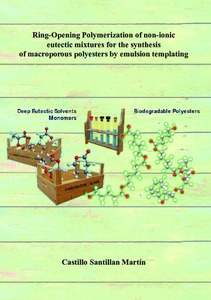
Ring-opening polymerization of non-ionic eutectic mixtures for the synthesis of macroporous polyesters by emulsion templating
(2024) Martin Castillo SantillanThis work encompasses the study of the sequential ring-opening polymerization (ROP) of deep eutectic system monomers (DESm) composed of L-lactide (LLA) and ε-caprolactone (CL) at low temperatures and in solventless conditions.
The tunable average molecular weight, crystallinity, polymer architectures, and controlled degradation profiles of these polyesters depended on the organocatalysts employed, including 1,5-diazabicyclo[4.3.0]non-5-ene (DBN), a new catalyst for the LLA-CL DESm ROP. Thus, fine-tuning the synthetic parameters led to the synthesis of polymer blends and a block copolymer. The toolbox of DESm capable of undergoing low-temperature and solventless ROP was further extended to LLA and various lactones, including δ-valerolactone and δ-hexalactone. The ROP of these DESm was also catalyzed by guanidine- and sulfonic acid-based organocatalysts for LLA and lactones, respectively. Finally, polycaprolactone triol (PCLT) and OH-terminated polyethylene glycol (PEG) were investigated as multifunctional macroinitiators in the solventless ROP of LLA-CL DESm catalyzed by 1,8-diazabicyclo[5.4.0]undec-7-ene (DBU) and methanesulfonic acid. Branched or linear PLLA copolymers with PCLT or PEG, respectively, were blended with PCL after the sequential ROP of LLA-CL DESm. The insights gained into the DESm ROP in bulk were advantageously used to design polymerizable high internal phase emulsions (HIPEs) oil-in-DESm. These emulsions sustained the efficient organocatalyzed ROP of the continuous phase. The resulting polymer replicas of the HIPEs, characterized by macroporous and interconnected structures, were capable of sorbing crude oil.
The mild polymerization temperatures and solventless conditions stand as green features of the ROP developed in this work to prepare resorbable biomaterials with programmable degradation profiles.
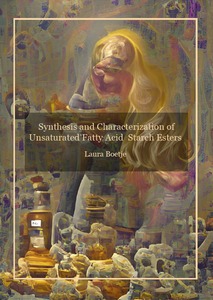
Synthesis and Characterization of Unsaturated Fatty Acid Starch Esters
(2023) Laura BoetjeThere is an increasing demand for plastics that are not made from fossil fuels and that have less impact on the environment. This is due to the projected exhaustion of petroleum as a resource, as well as the pressing issues of waste disposal and environmental pollution.
Starch emerges as a highly promising solution, due to its non-toxic nature, affordability, and widespread availability. However, its affinity for water and its behavior when heated pose challenges to its practical applications, but with suitable modifications it is possible to improve starch characteristics such that it can be used to produce films for use in packaging materials or mulch films.
In this work, starch was modified by a series of fatty acids with (saturated) and without (unsaturated) double bonds. Remarkably, the unsaturated fatty acids introduced more favorable thermal properties. Additionally, one of the unsaturated fatty acids induced antibacterial properties. Furthermore, starches derived from different plants were modified and their influences on the material properties were investigated. The use of unsaturated fatty acids for starch modification opens the possibility for the formation of a network through direct crosslinking, resulting in a tougher material. Moreover, these unsaturated fatty acids can be employed in a different reaction with other biobased molecules/polymers to create a network with tunable properties, further expanding the possibilities for applications.
Together these modifications show that starch modified with unsaturated fatty acids has enhanced properties and contributed to the development of new biobased plastic alternatives.
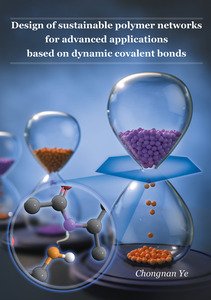
Design of sustainable polymer networks for advanced applications based on dynamic covalent bonds
(2022) Chongnan YeSynthetic polymers are one of the most important inventions of mankind, which are often categorized into two basic categories named thermoplastics and thermosets. Thermoplastics are linear polymer chains with the capacity to be reprocessed at high temperatures. Thermoset polymers, on the other hand, are made up of chemically crosslinked networks. Owing to their different topological structure, thermosets usually outperform thermoplastics in shape stability and creep resistance, but have worse reprocessing and recyclability.
With the development of covalent combinatorial chemistry, vitrimers, a group of dynamic polymer network, were first introduced by Leibler et al. in 2011. As a class of new covalent associative networks (CANs), vitrimers provide a solution to combine the best of both worlds. By including an appropriate transesterification catalyst to polyester-based epoxy resin networks, the permanent networks exhibit a gradual viscosity decrease upon heating, similar to vitreous silica, which is why the term “vitrimer” was coined.
In the last decade, vitrimers have drawn significant attention due to their recyclability, but they shouldn't be solely constrained to recycling thermosets in traditional plastic applications, like packaging, casting, and construction. Therefore, we have developed a library of sustainable dynamic polymer networks, vitrimers, for advanced applications. Owing to the synergy of dynamic covalent bond exchange reactions and employed function groups, a series of novel vitrimers were created to fit various applications, including water remediation, motion monitoring, energy harvesting and healable 3D printing.
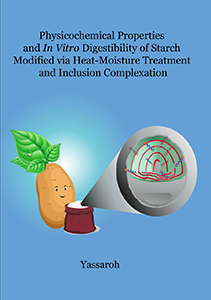
Physicochemical Properties and In Vitro Digestibility of Starch Modified via Heat-Moisture Treatment and Inclusion Complexation
(2021) YassarohStarch is the most abundant source of carbohydrate for human nutrition. Starch is used as an energy supply for the human diet. However, rapid digestibility of starch (RDS) leads to high glucose levels in the human blood, and studies to develop slowly digestible (SDS) and resistant starches (RS) become very important.
This thesis aims to scientifically study the starch modification process using low-cost food-grade ingredients and easily processable techniques to improve the resistance against α – amylase. Therefore, Heat-Moisture Treatment (HMT) followed by inclusion complexation with guest molecules was carried out to improve the physicochemical properties of the starch, thereby reducing its digestibility.
In this research, HMT was used as pre-treatment before inclusion complexation with guest molecules, to pre-gelatinize the starch granules par
tially. Furthermore, HMT promoted more stable physical cross-linking of starch chains in the granules, leading to the possibility of inclusion complexation at elevated temperatures without destroying the whole starch granule structure. Various types of fatty acids were employed, such as unsaturated; linoleic acid (LA), saturated; stearic acid (SA) and salt form; sodium stearate (SS). Our research shows that sodium stearate results in the highest temperature-resistant complexes compared to stearic acid and linoleic acid; hence, it results in the highest resistance toward enzymatic degradation of potato starch. Based on the in vitro digestibility results, it can be summarized that the amount of RDS from high to low is SA > LA > SS, while for SDS and RS, it is SS > LA = SA.
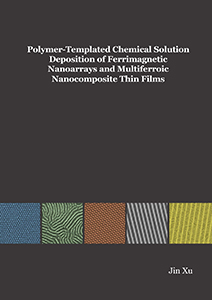
Polymer-templated chemical solution deposition of ferrimagnetic nanoarrays and multiferroic nanocomposite thin films
(2020) Xu, JinMultiferroic composites that combine the ferromagnetic and ferroelectric materials not only preserve the characters of the parent materials but also have a high potential for the interplay between the two ferroic orders. This interplay, known as magnetoelectric (ME) coupling, opens the door to a new type of applications, such as multi-state memories, electric-write magnetic-read hard disk drives (HDDs), and magnetic field sensors. With the ongoing trend towards device miniaturization, patterning (one of) the ferroic phases into ordered nanoarrays in thin films becomes increasingly desirable. The prevailing fabrication method so far is pulsed laser deposition (PLD), which requires expensive equipment.
This thesis demonstrates a low-cost alternative, which is based on chemical solution deposition and utilizes polymer thin films as templates. Highly ordered arrays of ferrimagnetic oxide nanoarrays were first fabricated on Si substrates, and transformed into nanocomposites by simply spin-coating a ferroelectric thin layer. All composites were proven multiferroic at room temperature. A ME coupling effect was demonstrated at room temperature as well. With its low cost, flexibility on pattern design, substrate, and material choices, we believe this approach can be easily extended to the fabrication of many other nanocomposite systems.
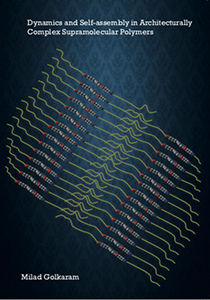
Dynamics and self-assembly in architecturally complex supramolecular polymers
(2020) Golkaram, MiladInspired by nature, a novel approach is introduced in order to form smart materials capable of self-assembly in the nanoscale.
These polymers, show well-defined morphologies similar to combs/brushes. As a result of comb/brush formation, extraordinary mechanical properties are observed which makes them an excellent candidate for super-soft reversible elastomers.
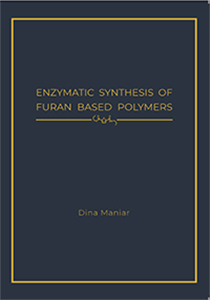
Enzymatic synthesis of furan-based polymers
(2019) Maniar, DinaFollowing concerns dealing with the finite nature of fossil resources and environmental pollution, interest in sustainable polymer alternatives and their production is rising. Enzymatic polymerization represents a promising solution to overcome these problems. The green nature and robustness of this type of polymerization gives rise to a multitude of biobased polymer.
Within a large variety of biobased building blocks, furan derivatives and furan chemistry occupy a special position in polymer chemistry. The similarity between furan and phenyl rings opens an opportunity to a biobased alternative for phenyl-based polymers. For instance, polyethylene furanoate (PEF) is one successful example of biobased alternatives to polyethylene terephthalate (PET), which is widely used as packaging material. Interestingly, even though many studies reported the use of enzymatic routes in the synthesis of aliphatic polymers, there is a limited amount of reports on enzymatic synthesis of furan polymers.
The work described in this thesis is focused on the further development of enzymatic routes for the production of various novel furan polymers with versatile properties. The obtained findings pave the way towards a transition from fossil- to bio-based polymers, as well as more environmentally friendly synthetic routes.
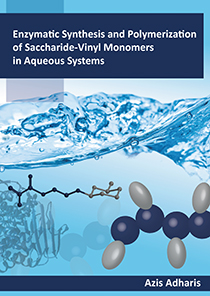
Enzymatic Synthesis and Polymerization of Saccharide-Vinyl Monomers in Aqueous Systems
(2019) Adharis, AzisCarbohydrates are a renewable biomass in which they are formed regularly through photosynthetic reactions in plants. The varieties of different carbohydrates in nature is abundant. However, the utilization of carbohydrates as polymeric materials only arose in the last few decades due to several reasons: First, most polymers are generated from fossil resources that are predicted to be exhausted in the next several hundred years. Therefore, carbohydrates offer an alternative renewable feedstock for this purpose. Second, the human awareness of creating more sustainable polymers, that have less impact on the environment compared to the fossil-based polymers, was improved. Third, novel functional polymeric materials can be developed when resources with complex functionalities, like carbohydrates, are incorporated in the polymeric structures.
For example, in recent years, it was reported that glycopolymers which are comprised of carbohydrates as pendant moieties have been developed and are suitable for applications such as disease inhibitors, biosensors, and drug delivery systems. Glycomonomers, the precursor of these glycopolymers, consist of saccharide units that are linked to some polymerizable groups. Currently, vinyl groups are the most exploited ones.
This thesis discusses the synthesis of several glycomonomers and polymerization of the monomers via environmentally friendly methods. The synthesis of saccharide-vinyl (macro)monomers utilized carbohydrates as starting materials and enzymes as biocatalyst. In addition, the glycomonomers were successfully polymerized by reversible addition–fragmentation chain transfer polymerization, free radical polymerization (FRP), and enzyme-mediated FRP in aqueous solvents. Double-hydrophilic and amphiphilic block glycopolymers were prepared and their self-assembly resulting in polymeric micelles was studied.
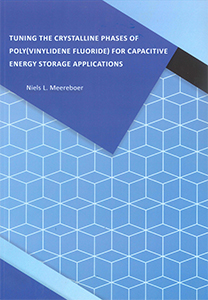
Tuning the crystalline phases of poly(vinylidene fluoride) for capacitive energy storage applications
(2019) Meereboer, NielsRadars, defibrillators, high energy lasers, power inverters in electric vehicles are all applications that require highly efficient capacitors having large discharged energy densities in their electronic circuits. Utilizing advanced plastics instead of ceramics as dielectric medium in capacitors offer unique advantages such as flexibility, ease of processing, reliability and, moreover, the ability to withstand high voltages.
In this respect, poly(vinylidene fluoride) (PVDF) is an excellent choice to serve as dielectric medium due to its high dielectric constant and high electrical strength, both contributing to high energy density materials. However, at high electric fields PVDF crystals transform irreversible to the ferroelectric crystalline phase, leading to drastically reduced discharged energy densities due to ferroelectric losses. Nevertheless, literature prescribes that these ferroelectric crystals can be beneficial for capacitive energy storage applications when they are well-isolated in nanodomains.
In this dissertation, distinct polymeric architectures based on (PVDF) are investigated to optimize the crystallization behavior of PVDF for enhanced dielectric properties. As such, block copolymer self-assembly proves to be a viable method to obtain isolated ferroelectric crystals in nanospheres, while also the temperature dependent crystalline phase transformations of poly(vinylidene fluoride-co-trifluoroethylene) (P(VDF-co-TrFE)) copolymers are studied. In the second part of the dissertation, it is discussed that vinyl alcohol (VA) can be incorporated in the PVDF and P(VDF-co-TrFE) backbone, giving ferroelectric P(VDF-co-VA) copolymers and relaxor ferroelectric P(VDF-ter-TrFE-ter-VA) terpolymers. The introduction of VA in the polymer backbone allows these polymers to be crosslinked, leading to novel polymers with appealing dielectric properties. Concerns regarding ferroelectric losses are mitigated, while the discharge energy densities and efficiencies are increased, highlighting the high potential of these materials for capacitive energy storage applications.
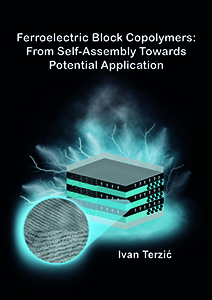
Ferroelectric block copolymers: from self-assembly towards potential application
(2019) Terzic, IvanFerroelectric polymers, such as poly(vinylidene fluoride) (PVDF), can crystallize in polar β-phase where C-F bonds are arranged with all the dipoles oriented perpendicular to the main chain and can be switched up or down by applying electric field. The high density of crystals prevents the dipole disorientation after the field removal, making them a good candidate for information storage. The presence of dipoles in PVDF and its high dielectric constant offer enormous potential in electrical energy storage. However, for this application, the ferroelectric nature of the polymer represents a disadvantage and can significantly reduce the efficiency of the device. The additional drawback of ferroelectric polymers is the lack of functionality that can add extra properties to the material and expand its use. Therefore, it would be highly beneficial to develop a simple method that can simultaneously tailor the ferroelectricity in PVDF-based polymers and add functionality to their structure.
The self-assembly of PVDF-based block copolymers represents a convenient way to prepare functional ferroelectric materials with easily tunable properties. Block copolymers consist of two different polymer blocks covalently linked to each other and which can phase separate into highly ordered nanostructures. In addition, the incorporation of the insulating block in the structure of the ferroelectric PVDF can screen the coupling forces between ferroelectric dipoles and induce a change in their response to the electric field.
This study investigates the self-assembly of PVDF-based block copolymers and explains their ferroelectric characteristics. The block copolymers were also used for the preparation of highly defined multiferroic nanocomposites, as well as nanocomposites with improved dielectric properties.
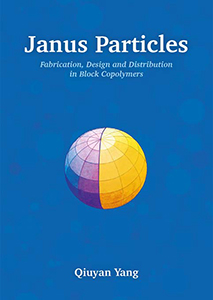
Janus particles: Fabrication, design and distribution in block copolymers
(2016) Yang, QiuyanThe quest for new smart materials with engineered properties and desired functionalities has recently driven scientists into the domain of nanotechnology. Incorporation of functional nanoparticles (NPs) into polymeric materials is an appealing research topic to generate highly ordered NP-based functional materials, which can be specifically used for flexible sensors, tunable plasmonic nanostructures for surface-enhanced Raman scattering, ultrafast switches and organic memory devices, and advanced photovoltaic devices.
Janus-type NPs, that are defined as possessing different surface chemical/physical compositions on the two sides of the particles, are a specific kind of desired building blocks to be incorporated into polymeric matrices. Due to the unique combination of amphiphilicity and particle features, they are particularly promising in the precise organization of multicomponent NPs at the interface or surface of polymer matrices with a high degree of order.
In the research presented in this thesis, we established a feasible technique to prepare Janus particles from spherical polystyrene templates with the assistance of carbon dioxide. By utilizing this approach, various types of Janus particles were designed and fabricated, with different sizes, varied Janus balances and diverse surface functionalities. Following the fabrication of Janus particles, the distribution of Janus particles within block copolymer matrices was studied with the aim to achieve highly ordered structures.
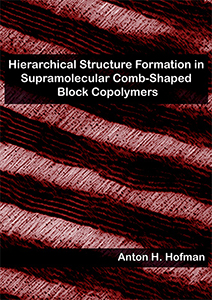
Hierarchical structure formation in supramolecular comb-shaped block copolymers
(2016) Hofman, AntonBecause of their chain-like architecture, blends of chemically different homopolymers are generally known to phase separate, similar to mixtures of water and oil. In block copolymers, however, two (diblock) or more (multiblock) of such macromolecules are covalently linked to each other, thereby making it impossible to phase separate macroscopically. Indeed, phase separation of block copolymers is confined to the molecular level. By changing the molecular weight or the composition of the copolymer, phase separation of diblock copolymers leads to spontaneous formation of numerous ordered structures with sizes ranging from approximately 10 up to 100 nm. Examples include lamellar, cylindrical and spherical structures.
Increasing the complexity of the macromolecular architecture usually leads to a more complex phase behavior. Structures formed by multiblock copolymers have for instance been thoroughly studied by both experimentalists and theoreticians. Since their synthesis is rather challenging, alternative, less demanding approaches are required for real-life technological applications. Supramolecular chemistry is one of these methods. By combining linear diblock copolymers and small organic surface active molecules, comb-shaped copolymers can be prepared by simply mixing both compounds. This often leads to the formation of multiblock-like hierarchical structures, i.e. structures within another structure.
The work described in this thesis is focused on the synthesis and self-assembly of a new class of supramolecular materials, so-called double-comb diblock copolymers. Microphase separation of such complexes resulted in several new, unique hierarchical morphologies that were not observed in block copolymer-based materials before. In addition, the general observed phase behavior was found to be in excellent agreement with previously developed theoretical models.
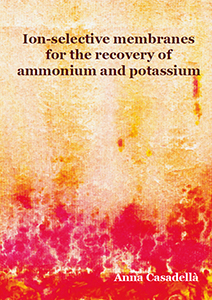
Ion-selective membranes for the recovery of ammonium and potassium
(2016) Casadella, AnnaOur planet is expecting a population growth in the coming years and so a higher demand of food production (i.e., crops) that will require higher crop yields. The demand of fertilizers (chemical or natural) is going to increase as they contain one or more of the essential elements (nutrients) necessary for plant growth: phosphorus, nitrogen, and potassium.
Urine is considered as a possible source of such nutrients because of its composition. In urine, sodium (Na+), potassium (K+) and ammonium (NH4+) are competitive cations in separation and the recovery process as they have the same valence (+1), very similar hydrated radii and very similar diffusion coefficient which renders separation by charge, size, and mobility unsuitable.
This research is based on the development and characterization of membranes selective for the recovery of potassium and ammonium - two of the essential nutrients. A membrane-based technology was chosen due to its possibilities in continuous systems as well as the feasibility to incorporate selective phases (organic and inorganic) to the polymeric matrix. Polymers, selective inorganic and organic phases and additives were studied for their chemical effects on the transport of the target nutrients across the membranes. The research performed shows that membrane technology is a promising tool for the separation and recovery of potassium and ammonium from competitive cations and that the transport mechanism is key to understand the membrane performance.
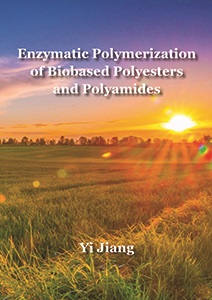
Enzymatic polymerization of biobased polyesters and polyamides
(2016) Jiang, YiNowadays "green" is a hot topic almost everywhere, from retailers to universities to industries; and achieving green has become a universal perspective. However, polymers are commonly considered not to be “green”, being associated with massive energy consumption and severe pollution problems (e.g. the “Plastic Soup”) as a public stereotype.
To achieve green polymers, three elements should be entailed:
(1) green raw materials, catalysts and solvents;
(2) eco-friendly synthesis processes; and
(3) sustainable polymers with a low carbon footprint, for example, (bio)degradable polymers or polymers which can be recycled or have a low environmental impact upon disposal.
By utilizing biobased monomers in enzymatic polymerizations, many advantageous green aspects can be fulfilled. For example, biobased monomers and enzyme catalysts are renewable materials which are derived from biomass feedstocks; enzymatic polymerizations are clean and energy saving processes; and no toxic residuals contaminate the final products.
Therefore, synthesis of renewable polymers via enzymatic polymerizations of biobased monomers provides an opportunity for achieving green polymers and a future sustainable polymer industry, which will eventually play an essential role for realizing and maintaining a green and sustainable society.
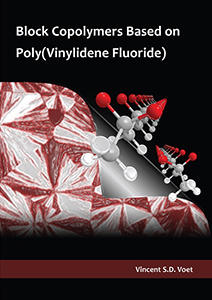
Block copolymers based on poly(vinylidene fluoride)
(2015) Voet, VincentIn recent decades, the hardware dimensions of electronic and storage devices for portable smart phones, laptops and cameras have scaled downwards, while their performance tremendously increased. To continue this trend in the near future, alternative materials need to be developed.
This research utilizes the intriguing nature of block copolymers to develop novel materials for data storage applications that are built into our everyday microelectronic devices. Block copolymers are large molecules composed of two different polymer blocks. Since both blocks are not compatible with each other (like water and oil), they phase separate on the nanoscale into domains of highly regular dots, lines or sheets, depending on the molecular architecture.
The precise self-assembly of block copolymers - used in this research - is a convenient way to build electronic devices, since the molecules arrange spontaneously into ordered structures and the dimensions and functionality can be tailored easily. In this research, we prepared block copolymers that include ferroelectric blocks.
The ability of ferroelectric materials to exist in different polarized states (“1” and “0”) and to switch the polarization in an electric field enables their application in storage devices. Our block copolymers were used to produce well-ordered ferroelectric nanofoams. Furthermore, we backfilled the polymer nanofoam with magnetic compounds to generate multiferroic materials composed of both ferroelectric and ferromagnetic domains. Potential coupling between the electric and magnetic properties will permit data to be written electrically and read magnetically.
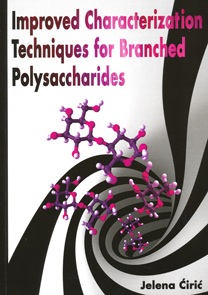
Improved characterization techniques for branched polysaccharides
(2014) Ciric, Jelena
Polymers are molecules, which consist of many repeating units (monomers). Starch and glycogen are natural polymers, and they are all around us. We use them on a daily basis but we do not understand them completely. Even though these sugars are simple concerning what they are made of (the repeating unit is glucose), they are hard to characterize. If there is a slight change in structure, polymers’ properties can vary a lot. For instance, a molecule of amylose consists of many glucose units that are connected via α-(1,4) linkages creating a long linear chain, which is insoluble in water. Whereas amylopectin actually represents a long amylose chain with many shorter chains (branches) connected to it with α-(1,6) linkages, and it is soluble in water.
In order to try to understand as much as possible about their structure and the relationship between molecular structure and the physical properties, the first steps are to create such polysaccharides. If you try to synthesize them via traditional organic chemistry, it is very hard and time consuming. Nevertheless if we copy nature and use enzymes as catalysts, the reaction is very easy. Enzymes catalyze specific things, like the formation of α-(1,4) or α-(1,6) linkages for synthetic amylose and amylopectin analogs respectively.
This thesis concentrates on the enzymatic synthesis of these analogs and their meticulous characterization with various techniques. Gathered information are used for unraveling parts of the synthesis mechanism and can be used in future for improved characterization and apprehension of natural polysaccharides.
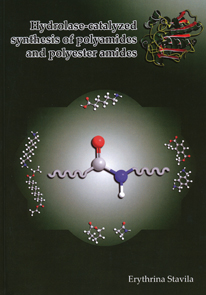
Hydrolase-catalyzed synthesis of polyamides and polyester amides
(2014) Stavila, Erythrina
Developments in enzymatic polymerization have been ongoing for decades. Various studies on the enzymatic synthesis of polyesters, polycarbonates, polysaccharides, polypeptides, and polyamides have been performed and some of them have been implemented on industrial scale. Lipases are the most used catalyst in the synthesis of polyesters and polyamides. Extensive studies on the kinetics and the mechanism of lipase-catalyzed synthesis of polyesters have been carried out already, but the enzymatic synthesis of polyamides has received less attention. Therefore, the current research aims to address this by focusing more on the enzymatic synthesis of polyamides in order to get a better understanding of its reaction mechanism.
Polyamides are widely used polymers in daily and industrial applications, due to their high mechanical strength and good thermal resistance. Synthesis of most polyamides involves the use of aggressive chemicals and high temperatures. Bio-catalytic approaches might be superior alternative synthesis routes, which can be performed under mild reaction conditions. In this research, the synthesis of aliphatic oligoamides (nylon-4,10, nylon-6,10, and nylon-8,10), aliphatic-aromatic oligoamides, and poly(ε-CL-co-β-lactam) was performed. These reactions were catalyzed by immobilized Fusarium solani pisi cutinase or Candida antarctica lipase B (CAL-B). Immobilized Fusarium solani pisi cutinase was prepared by two different methods: (1) physical adsorption on Lewatit (polymethyl methacrylate) beads and (2) cross-linked enzyme aggregates (CLEA).
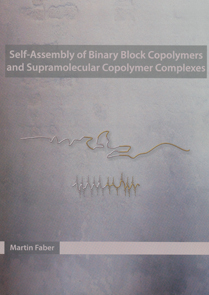
Self-assembly of binary block copolymers and supramolecular copolymer complexes
(2013) Faber, Martin
Self-assembly of block copolymers results in intriguing nanoscale morphologies due to the repulsive interactions between the different blocks. These microphase-separated structures are of interest for possible applications in nanotechnology. Subtle changes in the chemical structure of the monomers and the copolymer architecture can lead to enhanced control of the morphologies formed or even result in exciting new morphologies. It is therefore very important to obtain a better understanding of these parameters available to access and fine-tune specific morphologies.
This research describes the investigation of several self-assembling polymer systems, focusing on binary block copolymers and supramolecular complexes using hydrogen bonding. The supramolecular complexes consist of low molecular weight amphiphiles connected to a polymer backbone.
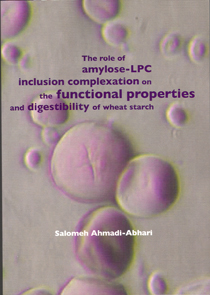
The role of amylose-LPC inclusion complexation on the functional properties and digestibility of wheat starch
(2013) Ahmadi-Abhari, Salomeh
Starch is the largest source of carbohydrates in human foods. It is a key component of staple foods like wheat, rice and potato. In addition, starch has been widely used in food products to modify texture, to control water mobility and to maintain the overall product quality during storage. Enzymatic degradation of starch results in glucose and due to this, starch in staple foods has been implicated in complications related to obesity, type II diabetes etc. Based on this, it becomes obvious that the rate of starch digestion is very important. A slow rate is considered positive since it leads to a lower metabolic stress. The present work studies wheat starch interactions with lysophosphatidylcholine (LPC) in great detail; starting with the effect on the functional properties, such as thermal properties and viscosity behavior of starch suspensions. The influence on the granular shape was observed by light microscopy, CLSM and SEM. The effect on the starch susceptibility to amylase hydrolysis was studied through a newly developed in-vitro method. The amount of reducing sugars after digestion were measured using DNSA reagent. The molecular size distribution of the starch molecules after digestion was analyzed by Size-Exclusion Chromatography. Suspensions with higher amount of LPC were more resistant to degradation at body temperature, due to higher amount of amylose-LPC inclusion complexes, as proven by a higher amount of amylose and a lower amount of reducing sugars. Iodine complexation with the digesta revealed the degree of amylose hydrolysis, proving lower digestibility of the inclusion complexes.
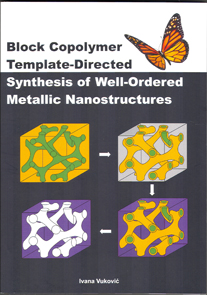
Block copolymer template-directed synthesis of well-ordered metallic nanostructures
(2013)Vuković, Ivana
3D nanostructured inorganic materials appear as promising candidates for various practical applications. This thesis focuses on metal nanofoams, a novel class of 3D nanomaterials that combine the properties of metals and nanoporous materials. This unique combination allows nanoporous metal foams to be used as, for example, hydrogen storage materials, actuators, novel 3D structured batteries, substitutes for platinum group catalysts, etc.
Common approaches, such as dealloying, sol-gel synthesis, nanosmelting, combustion synthesis, etc., render metallic nanostructures with highly disordered architectures which might have adverse effects on their mechanical properties. In contrast, block copolymers have the ability to self-assemble into bicontinuous ordered nanostructures that can be applied as templates for the preparation of well-ordered metal nanofoams. The idea of block copolymer template-directed approach, relevant experimental results and future perspective will be described in this thesis. Additionally, the phase behavior of block copolymer-based supramolecular complexes, employed here as precursors to well-ordered metal nanofoams, is thoroughly examined.
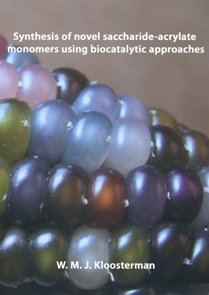
Synthesis of novel saccharide-acrylate monomers using biocatalytic approaches
(2013)Kloosterman, Wouter Marinus Jacobus
Polyacrylates with pending saccharide groups (poly saccharide-acrylates) combine the properties of saccharides with the hydrophobic properties of polyacrylates. The polymers are synthesized from monofunctionalized saccharide-acrylates. The synthesis of these saccharide-acrylates is difficult or even impossible by conventional synthesis routes, because the saccharides possess multiple hydroxyl groups with more less the same reactivity. Using biocatalysts on the other hand, has the advantage of high selectivity towards the bond formation.
The goal of this PhD research is to find biocatalytic approaches that can be used for the synthesis of monofunctional saccharide-acrylates.
Several enzymes of the glycosyl-hydrolase family are found to catalyze the reaction between hydroxyl functional acrylates and saccharides. The saccharide residues are obtained from cheap raw materials, like starch and cellulose (cotton).
As a result of the high selectivity of the enzymes used, the saccharide-acrylates contain only one acrylate group per saccharide. Furthermore, the selection of the appropriate enzyme can result in saccharide-acrylates containing one glucose group, one maltose group (two glucose residues) or a mixture of one to fourteen glucose residues.
Since the saccharide-acrylates contain only one functional group per saccharide, they can successfully be polymerized using (environmentally friendly) aqueous free radical polymerization in water. The resulting poly(saccharide-acrylates) are soluble in water. In the future, the novel kind of polymers can be used in applications like for instance dispersing agents in cosmetics, drug carriers and other biomedical applications.
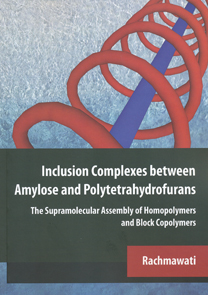
Inclusion complexes between amylose and polytetrafurans
(2012)Rachmawati, Rachmawati
Amylose is a linear polysaccharide having α-(1->4)-glycosidic linkages. The single helical V-amylose has a hydrophobic cavity that enables it to include guest polymers such as polytetrahydrofuran (PTHF). Amylose-PTHF complexes were prepared via direct mixing as it is more time- and cost-effective compared to the in situ complexation via “vine-twinning polymerization”. The complexes were formed immediately upon mixing of soluble amylose and emulsified PTHF. The degree of polymerization (DPn) and the end groups of the guest PTHF influence the complexation as the mechanism seems to proceed via insertion of the guest PTHF rather than wrapping around. The complexes are stable against storage, are yet reduced in organic solvents. Ethanol-washed complexes assembled as round spherulitic structures constructed of vertically stacked round lamellae.
The high melting temperature of the complexes (tm 125-145 °C) indicates a high crystallinity. Additionally, X-ray diffraction (XRD) demonstrates that the complexed amylose is in the form of V-amylose with 6 glucose residues per helix turn (V6-amylose), possibly a mixture or an intermediate between V6I- and V6II-amylose. This structure was also observed for complexation of low DPn PTHF with PTHF-b-amylose (tm complexes 120-139 °C). However, the V6II-amylose which indicates the presence of guest PTHF in between the amylose helices was observed in PTHF-b-amylose. This indicates that the structures of the corresponding PTHF-b-[amylose-PTHF complex] seems to be influenced by the organization of the block copolymer as well as by inclusion complex formation. Other polymers such as amylose-b-PTHF-b-amylose and three-arm PTHF-b-amylose were synthesized and are also expected to act as host molecules.
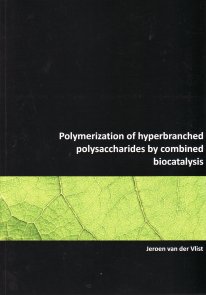
Polymerization of hyperbrached polysaccharides by combined biocatalysis
(2011) Vlist, Jeroen van der
In this thesis it is shown that enzymes are essential laboratory tools for the in vitro synthesis of polysaccharides with control over macromolecular properties. Here we present a method to enzymatically polymerize hyperbranched polysaccharides with control over stereoregularity, degree of branching and molecular weight. Moreover, the possibility to construct hybrid materials consisting of a hyperbranched polyglucan part connected to a synthetic substrate (e.g. polymer, surface, etc) is shown.
Using an enzymatic catalyzed tandem polymerization in which the unique properties of the enzymes potato phosphorylase and glycogen branching enzyme (GBEDG; from Deinococcus geothermalis) are combined, a hyperbranched polyglucan was polymerized consisting of (1→4) linked alfa-D-glucose residues with branches at the glucose C6 hydroxy group. In this tandem polymerization, phosphorylase catalyzes the addition of (1→4) linked alfa-D-glucose residues from a short oligosaccharide, using glucose-1-phosphate (G-1-P) as donor substrate (monomer). GBEDG introduces in situ branch points at the growing polymer chain. More specifically, GBEDG catalyzes the formation of alfa(1→6) branch points by the hydrolysis of an alfa(1→4) linked glycosidic linkage and subsequent inter- or intra-chain transfer of the non reducing terminal fragment to the C6 hydroxyl position of an alfa-glucan.
A property of phosphorylase, essential for the research as outlined in this thesis, is the donor substrate (primer) dependency. Polymerization is impossible without an oligomeric alfa(1→4) linked D-glucose primer of at least 3 glucose residues. By taking advantage of this property hybrid materials were constructed by anchoring the oligomeric primer to a substrate prior to the enzymatic tandem polymerization with. This resulted in hyperbranched multi arm structures, diblock copolymers consisting of a hyperbranched polyglucan part and hyperbranched brush polymers anchored to Si wafers.
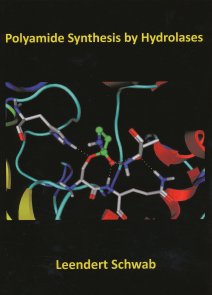
Polyamide synthesis by hydrolases
(2010) Schwab, Leendert Willem
In the past decades enzymes have become part of the chemists’ toolbox and they have proven to be effective in different organic reactions. Polymers produced by enzymes include polysaccharides, polyesters and even vinyl polymers. The synthesis of polyamides by enzymatic pathways is however not extensively studied. This project was started to synthesize polyamides by enzyme catalysis.
The enzymatic (Candida antarctica lipase B) ring-opening polymerization of b-propiolactam a 4-membered lactam ring in toluene is introduced. Optimally, the enzyme is dried for 24 hours over P2O5. A reaction at 55 °C yields enzyme with the highest DP.
Enzymatic catalysis can also be applied to the polycondensation of diesters and diamines. The polycondensation diesters and diamines is followed with ATR-FTIR spectroscopy over time. A comparison is made between the rate of amide formation by the uncatalyzed reaction and by the enzymatic reaction. At 60 °C the enzymatic reaction is slower than the non-catalyzed reaction.
Papain, a protease, catalyzes the homopolymerization and copolymerization of amino acid esters. Four hydrophobic amino acids were used, tyrosine, leucine, phenylalanine and tryptophan. A detailed analysis of the composition is done by MALDI-ToF mass spectrometry. When the chains grow longer in general more leucine is present and less tryptophan is incorporated in the chains. Tyrosine is slightly more reactive than phenylalanine. Phenylalanine produces short chains with apparently a low solubility.
Papain is able to synthesize amide bonds between amino acids and diamines. A series of monoamides based on protected glycine, phenylalanine and leucine and aromatic diamines can be synthesized catalyzed by papain.
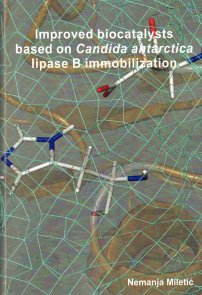
Improved biocatalysts based on Candida antarctica lipase B immobilization
(2009) Miletic, Nemanja
This thesis deals with an immobilization of the most widely used lipase, Candida antarctica lipase B (Cal-B), on different types of carriers. To this end, as starting carrier, a highly porous epoxy-containing copolymer was synthesized: poly(glycidyl methacrylate-co-ethylene glycol dimethacrylate) [poly(GMA-co-EGDMA)]. The properties of immobilized enzymes are highly influenced by the copolymer properties, in particular, porosity characteristics.
The use of poly(GMA-co-EGDMA) was motivated by the presence of epoxy rings in its structure that makes this copolymer highly reactive. Hence, various modifications of epoxy-containing copolymer were carried out. The influence of the type of immobilization on enzyme loading and enzyme activity is assessed.
After modifying the starting epoxy-containing copolymer, we turned our attention to Cal-B itself and tried to develop carrierless immobilization methods. Since, it was proved that Cal-B may successfully react with epoxy groups from the poly(GMA-co-EGDMA), modification and cross-linking with epoxy-containing compounds were chosen. With these treatments, in most of cases, activity and thermal stability of the Cal-B derivatives were significantly improved.
The standard procedure to evaluate the surface topography of immobilized enzyme and to characterize the architecture down to the molecular level is enzyme immobilization on flat surfaces. In order to immobilize Cal-B on silicon surfaces, pre-treatments with aminopropyltriethoxysilane and subsequently with glutaraldehyde were performed. Final enzyme properties are strictly determined by the structure and architecture of the aminopropyltriethoxysilane film, and all subsequent steps cannot significantly change the immobilization protocol. We have found the reaction conditions that favour creation of the perfect fully-covered aminopropyltriethoxysilane monolayer.
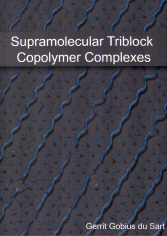
Supramolecular triblock copolymer complexes
(2009) Gobius du Sart, Gerrit
Block copolymers spontaneously assemble into nanoscale structures (10-9 m), which makes them suitable for applications in nanotechnology. The more complex the self-assembly, the greater the number of possible applications.
In this research, the phase behaviour of triblock copolymers (three blocks) and their supramolecular complexes with the amphiphile pentadecylphenol was addressed. Both the triblock copolymers as well as the complexes form very well ordered structures indeed.
Due to the fact that the amphiphile is attached to the triblock copolymer through hydrogen bonds, it is easily washed away after structure formation, thus creating a porous structure.
A 3D network structure was found for the first time for this type of block copolymer complexes. The networks were subsequently rendered porous by washing the material with ethanol. Such nanoporous networks stretch through the entire material by definition, a property which is very important for the possible applications. It can be used as a membrane material, but also the possibility to make nanoactuators out of it will be tested soon.
